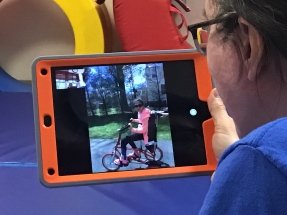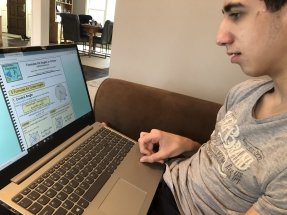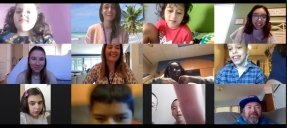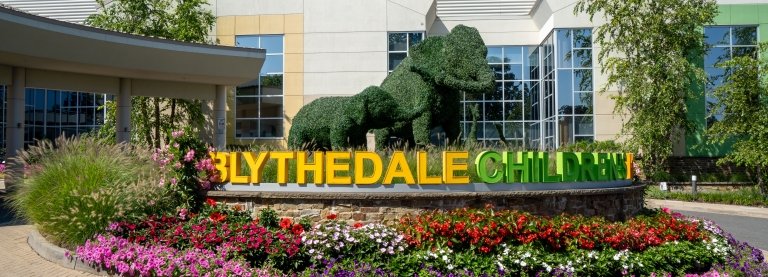Bringing the Hospital Home

Located in the epicenter of the United States coronavirus (COVID-19) pandemic, Blythedale Children’s Hospital was immediately impacted upon news of the deadly virus’ spread across the region. With social distancing rules put in place to slow the spread, New York State mandated the closure of schools, non-essential businesses, and ambulatory care programs. Blythedale’s Day Hospital, outpatient and specialized feeding programs were closed indefinitely, and classes were suspended at Mount Pleasant Blythedale Union Free School District (MPBS), the Hospital’s onsite school.
While parents and children nationwide grapple with hardships posed by school closures, those challenges are magnified for a child with complicated medical needs. For the more than 150 patients who attend Blythedale’s Day Hospital program and the MPBS, a transition to distance learning and telehealth was needed to ensure that not only was each child’s educational needs met, but that their medical and therapeutic regimens were addressed as well.
Hospital and school leadership moved quickly. The newly formed COVID-19 Leadership Team - comprised of senior management, clinical leaders, school administration and other key personnel - began meeting virtually every morning, seven days a week, to discuss and decide upon policies and procedures to not only keep everyone safe, but to ensure that children continue to receive the vital services they need to thrive.
"As soon as it became evident that New York State would be closing schools and ambulatory care programs, I knew we needed decisive action to ensure that our vulnerable population of children wouldn't face a gap in vital services," said Blythedale President & CEO Larry Levine. "These children have myriad complicating factors and are reliant on comprehensive therapies and educational programming daily. A swift implementation of telehealth services was critical to preserving the continuity of care."

"The first step was for the clinical teams to get together to identify the current therapy plan for each child and how that therapy plan could be modified to be performed remotely," said Dr. Scott Klein, Executive Vice President, Chief Operating Officer and Chief Medical Officer at Blythedale. "The therapists, nurses and doctors came up with individualized plans that would provide effective therapy sessions even through a camera. We recognized that healthcare usually means both verbal and physical interactions, but given the alternatives, verbal and visual would have to suffice. One advantage we had was that all of our patients and families were experienced in the therapy plans already. The goals of the telehealth sessions were to reinforce what we had already taught as well as make adjustments and enhancements to the plans based upon the feedback during the session."

“Telehealth at Blythedale is unique because it's focused on the therapies and exercises for the children, rather than the typical primary care provider model of describing symptoms and prescribing medication,” said John Flanagan, Vice President of Operations. “The ideal would be to have the kids here in person, but until it’s safe enough to bring them back to Blythedale, this program will be hands-on without being hands-on.”
Simultaneously, the School ramped up its ability to provide remote learning via virtual classrooms as soon as the mandated closure took effect. Teachers, faculty and staff contacted every student and family to check in and make sure resources were continually available, while working with local school districts to ensure access to distance learning.
“Literally we transitioned overnight; transforming learning experiences from a warm, inviting classroom environment to distance learning - using high and low-tech resources and equipment,” said Dr. Emily Hersh, Superintendent of the Mount Pleasant Blythedale UFSD. “We contacted parents, identified needs that included effective means of communication and access, and worked to provide a way for all students to continue to engage with instruction in a meaningful way. We’re providing these kids with the opportunity to learn, move and work on their individual goals, while continuing to make progress in rehabilitation and education."
There’s no substitution for face-to-face instruction, but this is a way to engage and keep continuity of learning and recovery.”
Some examples of distance learning include online story times with the librarian and teachers, Zoom sessions to ensure personal connections and shared learning continues,
pre-recorded circle and calendar time for students to review and follow along via Google docs, lessons recorded on YouTube to review and replay, and more.
“This new environment is helping our students become more independent learners and thinkers,” said Hersh. “They are growing and so are the relationships with their families, classmates and teachers. Now, they reach out more to each other for help and support.”
For one Blythedale parent, whose daughter Keira (nicknamed “Kiki”) attends fifth grade in the MPBS as a Day Hospital patient, these new experiences outside the School and Hospital have proven helpful in maintaining a sense of structure.
“Telehealth has been a great resource to keep all her Blythedale therapies going while we are at home,” said Lauren Cunningham. “Kiki loves seeing her providers and participating with them to continue her care through this uncertain time.”

"The kids are super proud to show the therapists their world - their siblings, their bedroom, their stuffed animals," said Klein.
It is something new for us too, and we are honored to be a guest in their home."
“It’s been great to see all of Blythedale come together and support this program to ensure we are providing the best therapeutic opportunities for our patients in times of need,” said Flanagan. “We’re very proud of how we could ramp this up so quickly and what our team accomplished in such a short period of time.”



